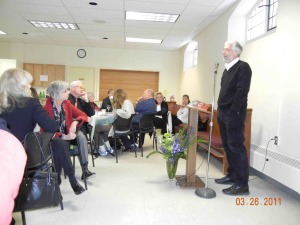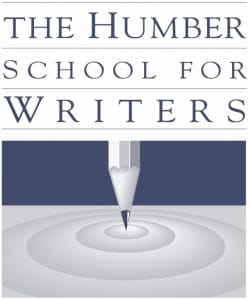You can find the interview here.
Author: Antanas Sileika
A Week in Canadian Literature
It’s been a busy week of literary appearances, most of them for my novel, Underground.
On Thursday, April 27, I was at the North York Public Library in front of a small crowd of twenty or so who peppered me with questions on the research for Underground as well as some of my older books.
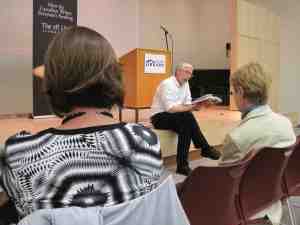
On Friday, April 29, I was reading for Diaspora Dialgoues at the Central Library. Diaspora Dialogues, run by Helen Walsh and Co, do good work bringing immigrants and immigrant writers into the Canadian literary world. One of the readers that night was Joyce Wayne, a lovely journalism teacher from Sheridan who ran a special program for immigrant journalists. We at Humber took one of her graduates, Myank Bhatt into the correspondence program in creative writing, where he is working with M G Vassanji, and I have high hopes for good literary outcomes there.
On Saturday, April 30, I attended the Random House Open House cocktail party at the Bar Mercurio. All the Random House luminaries were there, from president Martin to Louise Dennys and publicist Randy Chan (delicious hors d’oeuvres included steak tartare) . I talked for a while to Harbourfront director Geoffrey Taylor, who was just back from literary events in Ireland, and then to James Bartleman, former lieutenant governor of Ontario and Humber alumnus. A couple of former Humber publishing students were there as well.
On Monday, May 2, Snaige and I drove to Ottawa for, among other things, tea at the American ambassador’s house. It turns out she is a supporter of literature. There, I met Madeleine Thien for the first time and chatted with Sylvia Tyson and Elizabeth Hay. An embassy official was playing show tunes on the piano, but he took a break as American poet, Robert Pinsky recited some poems by heart. The residence is a stunning pile up on a hill overlooking the Ottawa River with some decent art on the walls including a Georgia O’Keefe and an Emily Carr. It is hard to imagine a more beautiful setting.
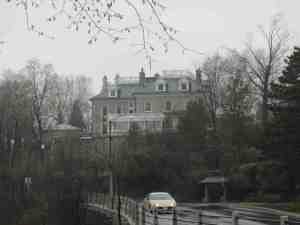
Then it was down into Ottawa to Arc the. Hotel, a hipster-cool black place where I felt as if I should always be speaking in hushed tones. On Tuesday night, May 3, I read and spoke in the Mayfair Theatre along with Humber alumna Suzanne Desrochers (Brides of New France) and Sarita Mandanna (Tiger Hills). The old theatre served popcorn during the talk – a nice break from the habitual literary fare of canapés or cakes.
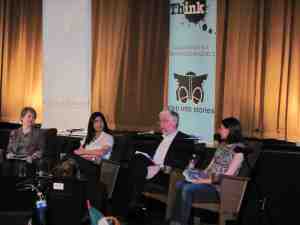
Afterward, I hung around the hotel hospitality suite with the excellent Ottawa festival organizers and David Adams Richards. The sesame shrimp were delicious, and after a few glasses of white wine, I was talking wildly about Canadian literature from Wayne Johnston to Michael Crummey, with David filling in a few discreet details. He doesn’t drink, so his restraint was better than mine.
On Wednesday, May 4, the Lithuanian ambassador, Ms Ginte Damusis, invited me to speak to the ambassadors of central European countries over a buffet lunch on the subject of my novel. We had representatives from Germany, Poland, Hungary, Romania, Bulgaria and other countries. They were interested in my talk of postwar partisans because many of them come from countries with similar post-war histories. The American ambassador’s wife, Julie Jacobson, was there too and all of them took away copies of Underground. Then it was off to Dinner at the Blue Cactus later that evening.
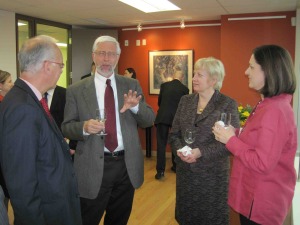
I should have gone to Humber alumna Sarah Raymond’s book launch at Type Books in Toronto on Thursday, but we were held up on the road in Gananoque, visiting my former Humber student Colette Maitland and Snaige’s art friends, Otis Tamasauskas and Jan, and so I arrived home too late to make it.
What would think literary exhaustion would set in, but I am deep into Jennifer Egan’s A Visit from the Goon Squad. She’ll be in Toronto in a couple of weeks.
New Review in the Edmonton Journal (and a Reprint in the Ottawa Citizen)
A a very thorough one at that
And then a reprint of an earlier one in the Ottawa Citizen.
Harbourfront Reading
It was great to read with Johanna Skibsrud and Suzanne Desrochers at the Harbourfront Reading Series last last Wednesday. It was a packed audience of over 300 people (the home ice advantage). Suzanne had come to the summer workshop at Humber back in 2006 ,and Johanna had once ben at SLS (Summer Literary Seminars) , with whom I worked in Lithuania a coupe of years ago.

- Johanna Skibsrud

- Suzanne Desrochers
Talks, Blogs, and Reviews
In the new world of book promotion, I’m finding the mass media monolith (alliteration is irresistible) of a short seven years ago when I published my last novel has devolved into a beach of promotional shards.
I think I might even like this landscape better, but it certainly is different.
Rather than speak to a hundred book salespeople at a mini-conference, I am going from store to store for short morning chats before the doors open. While it’s great to meet the people who might choose to hand sell my novel, I feel like I am speed-dating a hundred individuals this month.
When it comes to a blog tours, I stumbled across a joke I had missed when I was interviewed on Steven Beattie’s That Shakespearean Rag. I asked him how it was possible that the Canada Council could be funding blog tours when there are no expenses involved in that type of promotion. He smiled and reminded me the news item had run in the Quill and Quire on April 1. I realized I had missed the joke.
That interview was quite wonderful, at least partially because we talked intensely for an hour and Steven wrote the profile. Much harder are the new style interviews in which the host blog poses a series of questions the author should reply to. These types of interviews do provide a lot of space for an author, but I find I keep searching for ways to talk about my book in a manner I haven’t used before. I’m writing my own profile again and again, which is somewhat harder than merely talking about it again.
Perhaps it’s good to stretch this way.
Of course, one can’t help but be a little repetitive. Amusingly, I have noticed on my Facebook page that the number of “likes” is very high when I link to early interviews and reviews, and much lower later on.
No complaints. It’s wonderful to be out and noticed for one’s work, but one gets noticed in a different way now.
I’ve been very lucky in my reviews so far, having been covered in the National Post, The Vancouver Sun (with a reprint in the Montreal Gazette) and the Toronto Globe and Mail. That last review by Donna Bailey Nurse was particularly insightful.
Newspaper reviews are, of course, the remainder of the old monolith. But TV and radio shows about books have fallen on hard times. There are far fewer of them. Lost in the last few years were TVO’s Imprint, Newsworld’s Hot Type, and CBC Radio One’s Talking Books. Thank God for the ones that remain, namely Shelagh Rogers’s The Next Chapter and Eleanor Wachtel’s Writers and Company.
And what of the contact between writers and readers? The late Paul Quarrington told the story of stopping at a strip mall to buy worms for a fishing trip, only to see someone reading one of his novels on the sidewalk. He approached the man and said he was the author of the book. The reader looked up skeptically from the book and said, “No you’re not.”
New Reviews in Toronto and Montreal
Donna Bailey Nurse reviews Underground insightfully at the Toronto Globe and Mail.
The Montreal Gazette reprinted the very good review that ran last week in the Vancouver Sun.
Blog Tour at That Shakespearean Rag
Steven Beattie and I had a long conversation about the novel, historical fiction, and my literary obsessions at his blog.
That Shakespearean Rag
Notes from a Literary Lad
A Good Review at the Vancouver Sun
This review gives a broad, historical overview and ends with some positive remarks.
From Newspaper to Library to Bookstore to Newspaper
It was another busy literary week, starting with a lunch on Tuesday at a King Street restaurant called Buca, to celebrate the culling of over 2,000 story entries for the Toronto Star Short Story Contest. I won’t say much about this because the competition is still unfolding, except this – our bleary-eyed judges were glad to pass on the long list and to settle down for a lunch of “salumi”, as the various cured meats are called in this cooler than cool basement. restaurant.
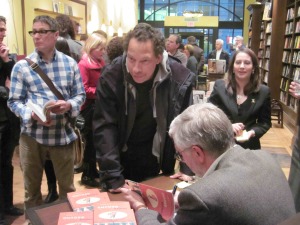
On Wednesday, I launched my novel, Underground, to a room of about 120 people at Ben McNally’s bookstore on Bay. (There will be a bigger launch/reading on April 13 at Harbourfront).
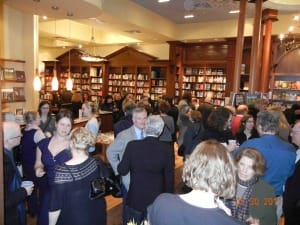
Friends and writers at that even included Lawrence Hill, Don Gillmor, Joe Kertes, Susan Swan, Karen Connelly, Anthony de Sa, Wayson Choy, Richard Scrimger, Kim Moritsugu, Erna Paris, Sally Cooper, Michael Helm, Andrew Clark, Catherine Bush, Anne Denoon, Michael Redhill, Eva Stachniak (who wrote a big review in a major Polish newspaper), John Bentley Mays, Margaret Cannon, Marni Jackson, Russell Brown, Donna Bennett, Andrew Westoll, Dawn Promislow, Nathan Whitlock, Leo Kamen, Katherine Ashenburg, Marni Jackson; journalists Mark Medley and Stuart Woods; publishers Lynn Henry, Marc Cote, and Jack David, and probably a few I forgot (so many names to drop – so little time). Friends, the whole Thomas Allen publishing team, and family warmed the room.
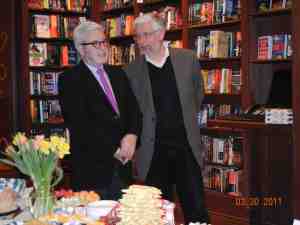
We drank lemon vodka frozen into a block of ice, homemade blackcurrant cassis and Lithuanian beer and ate bacon buns and napoleon cakes.
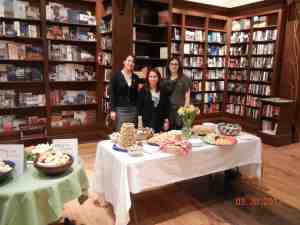
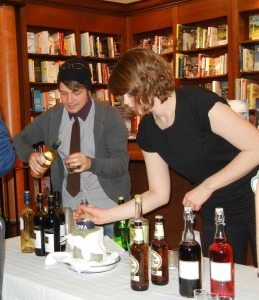
On Saturday, I was off to London, Ontario, for a Humber School for Writers event in the morning with Joan Barfoot at the London Public Library. We did mini-edits on first pages of writing for about twelve writers and I took 40 pages home for homework, promising to send back my results.
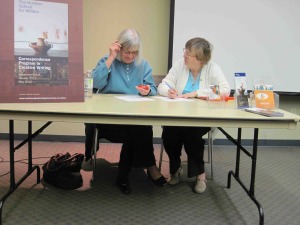
In the afternoon, I did a signing at Chapters in London, and then it was dinner with friends and a nighttime drive home to Toronto at midnight.
Too revved up from the drive to go to bed, I did a few emails and found a new review of Underground from the Vancouver Sun. It was a fine review and a good companion to the Tanqueray Rangpur gin nightcap I took before retiring to bed.
The Last Word on Historical Fiction
The last of my essays in The National Post on the subject of historical fiction and the place of my novel, Underground, within that context.
The Past is Slippery
Here is my latest essay, on historical fiction this time, at the National Post.
John le Carré territory
My second online essay at the National Post addresses Eastern Europe as John Le Carre Territory.
On Writing Underground – on Writing History
The first of my series of brief essays on the background of my latest novel and on writing historical literature in general appears online at the National Post today.
Back on the wheel of Fortune
Now that my new novel is out, I’ll run a few weeks of commentary about what it is like through the ups and downs of public life after years of seclusion at the writing desk.
Of course, I’m frequently out and about for literary events, but they are not my own and therefore less fraught. What follows is an emotional literary diary.
Since this is my fourth published book and third novel, I thought I would be immune from the pre-publication jitters, but I found myself up many nights at three AM, looking in the liquor cabinet for something to calm me down, and becoming alarmed at the falling level of Tanqueray Rangpur Gin (a spirit available only in the USA for some odd reason).
An early review in the Quill did nothing to preserve the gin stocks when it said some of the language in my novel was stilted (it also said the novel has “moments of startling power”, but the praise does not stick in the mind as much as the blame). I’d gone to great lengths to get the language as an evocation of foreign language – aiming for clarity with some of the rough directness of the peasant manner of speech of the country where the novel was set. Of course, this effect may not have worked for the reviewer, but it was not through lack of attempt to create a feeling.
On Saturday, the National Post ran a long review by Philip Marchand. I was amused that a half-page sketch of my face was printed on the page as well, captioned “Irresistible. As I’ve said elsewhere, this is a page I want to send out to a few girls with whom I didn’t have much luck in high school.

This was generally a very good review with great little comments like the following:
As the novel proceeds, that term “underground” acquires richer and richer layers of meaning….
Sileika’s novel is a gripping tale…
The review did, however, take me to task for not being funny as I was in Buying on Time, my collection of stories published in 1997. The observation is perfectly correct, but it talks about what I am not doing. I’m not writing science fiction either. Sometimes one writes comedy and sometimes one writes tragedy.
I do admire Marchand, though, because he is thorough and balanced. He’s reviewed all three of my last books.
Blaming a novel for not being something else was an appalling approach I noticed in James Grainger’s review of David Bezmozgis’s new novel, The Free World, in March twenty-seventh’s Toronto Star. Grainger does not like historical novels and he does not like family sagas, yet he reviewed the book and blamed it for being a historical family saga (do the seventies qualify as “historical” already?). This is like blaming gin for not being scotch.
Graingers’ ahistoricism is something I see very much in the Toronto literary community but not much anywhere else. I have addressed this curious provincialism in other posts.
Last night I read from the new novel for the first time at a church basement literary event at St. Peter’ Anglican Church in Mississauga. I was up with nonfiction writer Peter Edwards ( a journalist at the Star) Maggie Helwig (who told me she would soon be ordained as an Anglican priest) and The Reverend Jennifer E. Reid, the church pastor, who read some very funny unpublished material (she really should be published).
About seventy people were in the audience in this exquisite stone church in a very fine neighbourhood. I felt beloved as soon as I walked into the room, an unusual feeling for someone more accustomed to the edgier, critical assessments in literary Toronto.
This was a test run of my reading in public. I chose the opening passage of the novel, which involved the murder of five Communist party functionaries and the wounding of two innocents. The scene ends with pools of blood on the floor and splatters on the wall.
I delivered this between the salad and the soup courses.
The audience was attentive and they bought a good number of books, but I think that I’ll choose romantic scenes the next time I read at a dinner. One doesn’t want to think about pools of blood while looking at food on a plate.
This week, I launch at Ben McNally’s bookstore. I imagine other reviews might come, and I’ll talk about them as they appear.
As I was writing this post, I received a call from a journalist in Lithuania and did an interview about the novel for people over there. Everything I write about in this novel, the historical basis, is very well known in Lithuania. They wanted to know what was new about my take on the postwar partisans. I had to say I had nothing new to tell them aside from the fact that any underground war is dirty and human and complicated. What’s new over here, on this side of the Atlantic, is the entirety of the subject matter, quite part form the success or failure of the execution.
And for the next little while, I will cross post in both my Humber and personal blogs as I write not only about the literary scene, but my role in it. This is an odd moment in which I feel both like an actor and a film critic at the same time – it’s like writing in a hall of mirrors.
National Post Calls Underground “Irresistible”
Philip Marchand reviewed Underground in the National Post Today.
The hard copy of the newspaper has a large sketch of me labelled “Irresistible”. It’s a page I wish I could send to some of the girls I admired in high school.
To critique the critique, the review does insist that I am not writing humour – it insists a bit too much because I am indeed not writing humour in this novel – it’s about a fight to the death without a lot of laughs, but perhaps some tender moments.
But there is dark humour in the tone, a bit of “what fools these mortals be”.
Where is the writer who will agree wholeheartedly with a critic’s assessment? He also called the novel compelling and layered, and that’s pretty good.
Novel Excerpt at the National Post
See a preview of my novel, Underground, in the National Post.
The Lands Between – Part Two

Alexander Prusin’s The Lands Between is a study of the lands between Germany and Czarist and Soviet Russian from 1870 to 1992.
The map above, of the Polish-Lithuanian Commonwealth, loosely covers the area that both he and Timothy Snyder write about.
I’ve discussed his particular take on the postwar anti-Soviet partisan resistance in that area, but let’s step back now in order to get a sense of his overview.
He wonders why this area was so violent between 1914 and 1953. In effect, this shorter period covers the time of the fight for independence in those lands, as well as the independence period, and invasions from Germany and the Soviet Union and the Holocaust and the resistance after WW2.
The places were most violent when they tried to break away, and they were unstable because of ethnic tensions and economic backwardness.
Although he is not entirely in favour of the imperial regimes before WW1 and the Soviet Union after WW2, Prusin seems to imply that at least these lands between were less violent then. This assertion seems odd to me, given that the German and Czarist (later Soviet) forces were the ones that initiated the violence in the first place. At times, he sounds like he is blaming the victim, although it is certainly true that victims can also be perpetrators.
He is certainly right that the religions professed in the area were Lutheran, Roman Catholic, Eastern Orthodox, Uniate, Jewish, Karaite and other sects, and languages were as many or more. Before WW1 in Lithuania, the government activity happened in Russian, culture in Polish, some business and most Jewish home life in Yiddish, and farm and peasant life in Lithuanian.
These lands were multicultural avant la lettre, but not in a good way, according to Prusin. Current expressions of multiculturalism are usually deemed as positive. In the place and time described, the different confessions and linguistic groups cooperated when times were good, friction turned to fire when times were bad.
Interestingly, Prusin accuses the state of being the prime instigator of violence by encouraging latent hostilities. He does not exclude Soviet and German states, but neither does he limit the blame to those two.
And controversially, he says that large-scale collaboration was required to make the German and the Soviet occupations work. I have italicized the second part of the last sentence because traditional understanding of the term collaboration in the West put it solely in the Nazi camp. Prusin is saying that one could collaborate with the Soviets as well. There is nothing new in this understanding in the East, but it might be new to Westerners.
Prusin also states that the local population had no control over political and social processes.
One item that Prusin finds consistent is that Jewish communities were singled out as targets in the Czarist, independence, and wartime periods.
Particularly in the first days of the Holocaust, Prusin sets out this scenario: As the Soviets retreated under the German attack in 1941, they instituted a scorched earth policy and began mass executions of prisoners, usually local elites (teachers, politicians, policemen the Soviets had arrested earlier). These massacres were carried out in a gruesome fashion.
As I said to a friend of mine, people have just begun to understand about Katyn – they are just beginning to know that there were many more murders like that one, and they remain unknown in the West.
Due to the Soviet violence (and the mass deportations of just a week before), says Prusin, the German were greeted with genuine enthusiasm by non-Jews. Then the mutilated bodies of the former Soviet prisoners became public knowledge, and vengeance was twisted to be visited upon the Jews. However, violence upon the Jews was also initiated in places here there was no Soviet violence. Furthermore, nationalists envisioned a fight against communism as a fight against the Jews, and so we end with mass killings of Jews by many, many local German collaborators. Most active among them were policemen and others who had been imprisoned under the Soviets or lost relatives to them.
This point reinforces Timothy Snyder’s thesis (in Bloodlands) that the violence was worst where German and Soviet regimes overlapped.
In the postwar era, peoples and borders were moved to make homogeneous areas. The removal of multiculturalism, as we understand it, led to stability (not a solution we like to think about in multicultural Canada).
The violence in that part of the world, says Prusin, was so bad because it was initiated by the state and exacerbated by popular participation. In other words, it was total war.
Prusin states that things have calmed down in the region, but there are still dangerous historic legacies. First, the new countries (Baltics, Poland and Ukraine) have attempted to define themselves in terms of territory, ethnicity, and citizenship as they did after WW1. Indeed the Canadian writer, Anna Porter, has pointed out that the right wing is rising in central Europe, and signs of right-wing extremism are rising in the borderlands as well.
Second, the entire area is dependent on Soviet natural resources. Therefore, although the states are democratic and independent, they are torn between the globalization of the West in the EU and subservience to the East’s oil and gas.
The place remains inherently vulnerable to outside forces.
Blog Tour Now On
Underground is a historical literary thriller with elements of espionage and romance.
It’s set a very short time ago, just after the second word war, but in a part of Europe whose stories are untold and whose geography is obscure to most of us on this side of the Atlantic.
What are lovers in this place and time to do when history crashes into their personal desires and private lives?
I’ll be on a blog tour for the next couple of months, being reviewed and interviewed, so look for me and for talk about the book at the links down below. Some of the dates will follow later.
And on a final personal note, I wrote this novel trying to make it something a reader could easily fall into and live happily with for a few days, so I hope that turns out to be the case for you.
To start you off, se Eva Stachniak’s detailed interview at the first link below. I have the first three linked – the others to follow.
Eva Stachniak – currently available
The Afterword – The National Post, March 28 to April 1
That Shakespearean Rag – currently available
Open Book Toronto – currently available
Rob McLennan – forthcoming
Stepping back for a Long, Hard Look
A new overview of the territory between Russia and Germany has just appeared, called The Lands Between, (Conflict in the East European Borderlands, 1870 – 1992), by Alexander V. Prusin.
This history covers some of the same territory as Timothy Snyder’s Bloodlands with a few differences. For one, Prusin’s book is almost three times more expensive than Snyder’s costing a hefty sixty plus dollars in Canada.
Also, the historical range is longer, taking us back to the time before WW1 when the area was dominated by three powers – Czarist, German, and Hapsburg, and continuing to 1992.
As well, Prusin is considerably less sympathetic to the inhabitants of these lands, depicting them as inhabited by squabbling ethnic and religious rivals. Pressed by either Germans or Soviets, these rivalries became exacerbated and murderous, with the Jews the major but far from only victims.
Curiously, the least troublesome era in Prusin’s history seems to be the time before WW1, when religious and ethnic rivalries were controlled by the old empires. By implication, he seems to be saying these are areas guilty of irredentism when not suppressed by outside powers, yet the outside powers were trying to mold the area to their own image (in the case of the Czarist lands, by imposing the Cyrillic alphabet and orthodox Christianity).
The part of the history which interests me most is this text’s take on 1944-1954, the era of the anti-Soviet underground resistance. Prusin characterizes this period as one of civil war between collaborators with the Soviet regime and those who opposed them. As happened all too often in this part of the world, brutality upon brutality led to escalating violence until one side won, in this case, the Soviets.
Here’s a bit more detail on that – as the local partisans fought against the Reds, they forbade locals to take up positions of responsibility in the new Soviet administration. When collaborators did so anyway, the partisans attacked them. These attacks led to counterattacks by the relatives of deceased collaborators, backed by the Soviet army and secret police. In Lithuania, these Soviet forces numbered 12,000 security personnel and 40,000 – 60,000 troops.
This claim is slightly problematic because it begins with the attack by the partisans rather than the attack on the whole country by the Soviets. Notwithstanding that, let’s continue.
In the last six months of 19444 alone, once Lithuania was free of German troops, the Soviets arrested more than 22,000 individuals and carried out over 8,000 anti guerilla actions. The following year they captured 58,000 people.
In this dirty war, some of the Soviets disguised themselves as partisans and went out to commit atrocities. Partisans who were killed were stripped to their underwear and dumped in public places. Soviet propaganda also denounced the partisans as criminals and wartime German collaborators.
In 1953, the Lithuanian underground still managed to kill 84 Soviet functionaries, but by then the area was saturated with police and informants and the partisan war was essentially over,
Prusin points out that the vast majority of functionaries killed by the partisans were Lithuanians themselves, about 21,000 of a total of 25,000 killed, including, 1,000 children. Thus the partisans were trying to prevent collaboration, but failed, and their victims included many innocents.
The whole question of collaboration is thorny in this part of the world. Simply to exist, one likely had to collaborate either with the Germans or the Soviets. There was no other option in this unhappy slice of geography.
Prusin’s view of the partisan war in Lithuania as a civil war is interesting, but it does concern me that it lets the Soviets off the hook. If the Lithuanians were simply fighting one another, I might agree, the the internecine fighting occurred precisely because the Soviets were there. without them, this particular slaughter would not have happened.
I’ll give an overview the rest of Prusin’s history book in my next post when I’ll discuss the broader context for the postwar partisan resistance.
Gossip at my Creative Writing Posts Over at Humber
I’ve been posting on creative writing and gossip about literary events at my Humber School for Writers blog. Come on over and see what I’m up to over there.

